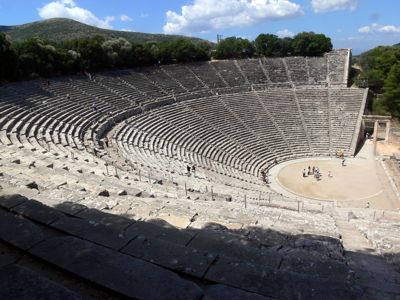A magazine where the digital world meets the real world.
On the web
- Home
- Browse by date
- Browse by topic
- Enter the maze
- Follow our blog
- Follow us on Twitter
- Resources for teachers
- Subscribe
In print
What is cs4fn?
- About us
- Contact us
- Partners
- Privacy and cookies
- Copyright and contributions
- Links to other fun sites
- Complete our questionnaire, give us feedback
Search:
Naturally splendid acoustics
Stadium concerts are only possible because of modern loudspeaker technology. It means that even people far from the stage can hear the band. Clever as we are, the ancient Greeks solved the problem without the technology. They just used the seats. Dimitrios Giannoulis a researcher at Queen Mary, University of London explains.
The ancient amphitheatre of Epidaurus in Greece has extraordinary acoustics that left researchers baffled for years. The theatre's design somehow made it possible for people at the back to clearly hear the play despite being more than 60 meters from stage. How was it done? Is there something special about the slope of the ampitheatre? Is it something to do with the shape channelling the wind in a way that drives the sound forward? In 2007, researchers from Georgia Institute of Technology finally cracked the problem. Its acoustic excellence is all down to the size, material and row spacing of the seats.
The seat rows play the role of what is known as an `acoustic filter'. They make different sounds scatter in different directions depending on their frequency. The result is that some sounds, here the lower frequencies, are 'damped': they become much quieter. That means the high frequencies sound louder in relation to the low ones. Filtering out the low frequencies in this way removes background noise such as the sound of the wind, rustling trees and the murmuring of the audience. There is a further boost to the sound reception too, because the higher frequencies also reach the audience by being scattered back from the seats behind. Together these effects improve the clarity of a speaker's voice throughout the theatre, giving it its renowned acoustics.
For the amphitheatre of Epidaurus, the threshold frequency that matters is 530HZ. Lower than that and the sounds are damped. Higher frequency sounds are amplified. That raises a problem though. The lower frequencies of the human voice fall into this lower range too. Why isn't the speaker's voice filtered away? It turns out not to be a problem because our brains cleverly reconstruct the missing sound of our voices from the high frequency information available. This same effect is often used today to create the illusion of bass in sound systems that are not actually capable of producing it.
The acoustics of Epidaurus are unquestionably special and that's why the architects of later ancient Greek and Roman theatres tried to copy the seat row design. Perhaps we should think about doing the same more often too.



